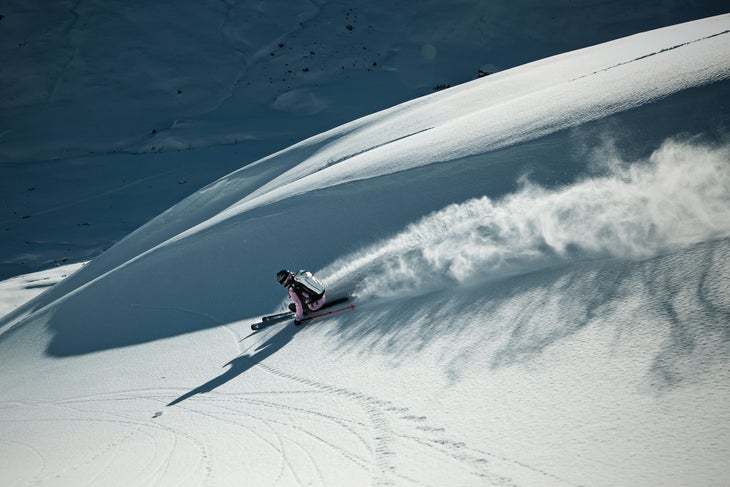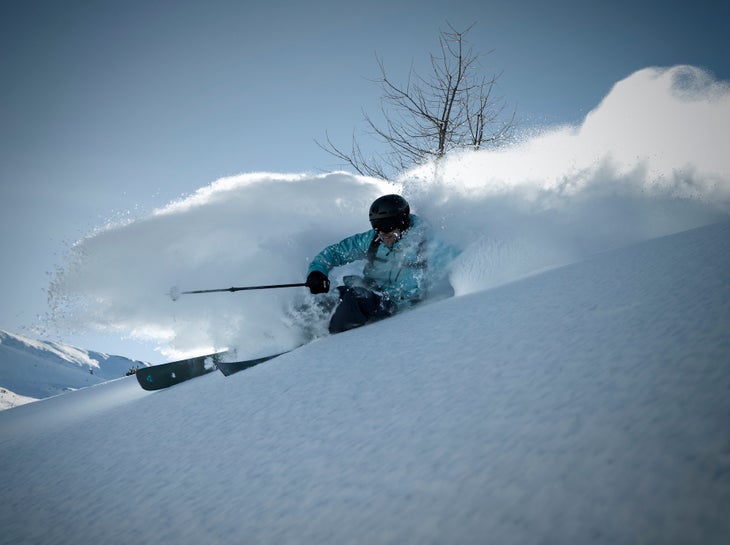Products You May Like
Receive $50 off an eligible $100 purchase at the Outside Shop, where you’ll find gear for all your adventures outdoors.
Sign up for Outside+ today.
Fischer is doubling down in the all-mountain ski category. For 2022-’23, the heritage racing brand born and bred in the Austrian Alps is scrapping its existing all-mountain Ranger line and replacing it with a brand new, entirely overhauled Ranger series.
That means no more Ranger 94 FR, winner of SKI Test Gold in the women’s all-mountain category; no more Ranger 99Ti, a wider all-mountain option that our gear testers loved for its responsiveness; no more Ranger 115 FR, the ski for hard-charging storm chasers; and most distressingly, no more hot pink Ranger 102 FR, a ski that’s only been around for two seasons but has already gained a cult-like devotion among skiers in the know.
Related: Check out the 10 Best in Test skis of 2022
In their stead, Fischer presents to you a new lineup of Rangers—the Ranger 90, Ranger 96, Ranger 102, Ranger 108, and Ranger 116—designed to do everything the original Rangers did, but better.
“We analyzed the needs [of skiers] and the critical waist widths. We also analyzed the competitors to check out the benchmark skis for all of these different waist widths,” explains Christian Haas, Alpine Product Manager for Fischer. “The result is a more trustworthy, all-day-long freeride range.”
Does that mean the old Ranger series wasn’t dependable and ideal for day-in, day-out skiing? It was, but only if you were an advanced and expert skier with the skills to tap into the old Ranger skis’ power and precision. The old Rangers, though part of a freeride line with a twin tip shape, still very much carried Fischer’s racing DNA and perpetuated the stigma that Fischer skis are burly and aggressive.
Watch: Fischer Ranger Development Story
So Fischer put its global athlete team to task in developing a new Ranger family, including U.S. big mountain skiers Lynsey Dyer, Sophia Schwartz, and Kyle Smaine. Their mission: To help create an all-mountain ski line that would launch a new era for Fischer, something that signaled to skiers everywhere that Fischer makes skis that can be enjoyed by all, and suit a variety of skier abilities, terrain, and snow conditions.
“The main goal was to create more playful, forgiving, and softer skis,” says Haas.
To savvy skiers, that might sound like Fischer decided to just dumb down the original Ranger skis to appeal to a larger market segment. But that’s not the case. The ’22-’23 Ranger skis feature entirely new geometries and construction technologies, and the result is that the line now includes a little something for every type of skier—without sacrificing the precision and performance we’ve come to expect from Fischer skis.
What’s New in the ’22-’23 Fischer Ranger Line?

The most significant difference between the old and new Ranger line is the overhauled construction technology. The old Ranger series included two different types of constructions, as seen in the Ranger Ti models versus the Ranger FR models.
The Ranger 92 Ti and 99 Ti included two full sheets of Titanal throughout the length of the ski to add stiffness, dampness, and stability at high speeds and through variable snow conditions. The Ranger FR models (90 FR, 94 FR, 102 FR, 115 FR), on the other hand, included only a Titanal plate directly underfoot to support precise energy transfer while lightening the load throughout the rest of the ski for more playful performance and easier handling off the groomers.
This meant that the Ranger Ti models had a knack for crushing groomed terrain and crud, but felt a little burly and unyielding in softer snow conditions or in tight terrain. The Ranger FRs were stellar off the groomed terrain, but not as energetic, responsive, or reliable in firmer conditions.
In other words, there wasn’t a Ranger that was versatile enough to handle it all. To solve for that, Fischer introduces its new Shaped Ti technology in the ’22-’23 Ranger lineup.
Each new Ranger now features an individually cut Titanal plate to suit the ski’s designated purpose. The narrower the ski (i.e. the new Ranger 90 and 96), the longer the Titanal insert in the core of the ski to promote better responsiveness and precision on groomed terrain. The wider models—the Ranger 102, Ranger 108, Ranger 116—feature a reduced amount of Titanal along the length of the ski to make it softer, more forgiving, and playful in variable snow conditions and in powder.
Related: What is Titanal and why is it used in skis?
Beyond a tailored Titanal plate, each new Ranger was also built with a unique Flex Cut and tail profile to better suit the type of skiing each ski was designed for. Because the narrower Rangers are built to enhance on-trail performance, the Ranger 90 and 96 feature a flatter tail and smaller Flex Cut in the center of the ski. The wider Rangers are designed to be more playful and versatile, so they include a more rockered tail and bigger Flex Cut to enable easier smearing and drifting.

Finally, perhaps not as significant in terms of performance but a huge win nonetheless, the new Ranger series is more sustainably made than the old line. Each new Ranger model uses between 20-25 percent recycled steel edges, zero-waste wood cores, recycled base materials, and the whole line is made in Austrian production facilities that use 60-percent solar energy.
Overview of the ’22-’23 Fischer Ranger Line
Fischer Ranger 90
- Dimensions: 129-90-114
- Available lengths: 156, 163, 170, 177, 184
- Radius: 17m (177cm length)
- Weight: 1,850g (177 cm length)
- Price: $750

Fischer Ranger 96
- Dimensions: 128-96-119
- Available lengths: 159, 166, 173, 180, 187
- Radius: 18m (180cm length)
- Weight: 1,950g (180cm length)
- Price: $850

Fischer Ranger 102
- Dimensions: 138-103-128
- Available lengths: 155, 162, 169, 176, 183, 190
- Radius: 19m (183cm length)
- Weight: 2,050g (183cm length)
- Price: $850

Fischer Ranger 108
- Dimensions: 143-109-134
- Available lengths: 171, 178, 185, 192
- Radius: 18m (185cm length)
- Weight: 2,120g (185cm length)
- Price: $950

Fischer Ranger 116
- Dimensions: 147-116-137
- Available lengths: 180, 187, 193
- Radius: 20m (187cm length)
- Weight: 2,150g (187cm length)
- Price: $950

As with the old Fischer Ranger line, the new line is entirely unisex and does not offer women’s-specific models. Instead, Fischer has intentionally designed these skis to perform regardless of gender and simply broadened the available lengths so that both women and men can find their appropriate length for each model. The Ranger 90, 96, and 102 are available in two top sheets, however, so that men and women can select their colorway preference. All of the new Ranger models are already available at select retailers across the U.S., including evo, Ski Essentials, Powder 7, Ski Monster, and Sturtevants.
